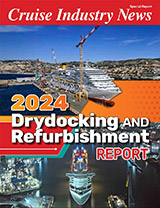Shorepower
With stricter environmental regulations being introduced in North America and Europe, the cruise industry is working to keep up with innovative solutions and compliance.
Contributing to so-called green ports and reduced emissions in metropolitan areas, ships are burning low sulfur fuel in ports in Europe, according to a European Community directive, while some U.S. ports are offering the opportunity to plug into electric power from shore, thus eliminating ship emissions altogether.
So-called AMP (alternative marine power), or cold ironing, is now offered in the major West Coast ports, although usually limited to one or two ships at a time. California will also require that a certain percentage of calls have to plug in, starting in 2014.
Next in line to offer shorepower is Brooklyn’s Red Hook terminal in New York.
The North American ports that are offering shorepower also have sufficient power supply and benefit to some extent from grants for construction and installation, and by reducing emissions will avoid EPA penalties and qualify for federal funding for transportation infrastructure.
Cruise Industry News talks to the ports that offer shorepower to cruise ships in North America; European ports that offer shorepower to ferries; and gets viewpoints from ports, cruise lines and industry associations on the viability of shorepower.
ECA Alternatives
The North American Emissions Control Area (ECA) will be in full force, requiring a 0.1 percent fuel sulfur limit starting in 2015. Meanwhile, the first phase of the ECA will enter into force Aug. 1, 2012, with a 1.0 percent sulfur limit, according to the EPA. In a statement to Cruise Industry News, the U.S. Environmental Protection Agency (EPA) reiterated that the ECA was adopted by the IMO as of March last year, and that the implementation dates are not expected to change. Meanwhile, the EPA is open to discussing what it calls innovative approaches.
MCI Drill: What If?
The U.S. Coast Guard, along with Royal Caribbean Cruises, and local, state and federal agencies, including the American Red Cross, successfully completed a Mass Casualty Incident Drill (MCI) last week in Bar Harbor, Maine.
The drill was designed to see what would happen in a relatively rural community with a sudden onslaught of cruise passengers needing medical care.
Charleston Row
Charleston has been the subject of national attention lately, as skeptics question the planned new cruise terminal’s affect on the city. Local media has turned plans to build a new terminal 1,500 feet from the existing facility into what appears to be a massive row from the outside.
The Industry in Numbers: 2011
The cruise fleet: 270 ships; passenger capacity: 18.1 million; estimated sales revenue: 28.9 billion plus. Cruise Industry News breaks down the industry by region, major markets, and product differences.
Ponant: 20,000 passengers
Compagnie du Ponant expects to break the 20,000 passenger-mark for the first time in its history by the end of this year, up almost 40 percent from 2010, according to Jean Emmanuel Sauvee, CEO.
For the full reports, please read the May 31, 2011 edition of Cruise Industry News, the Newsletter, click here to subscribe



